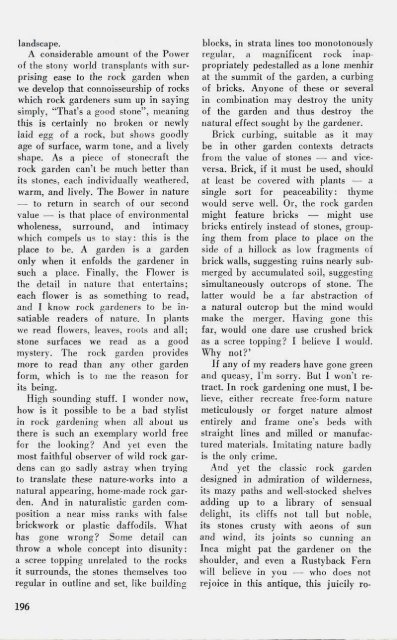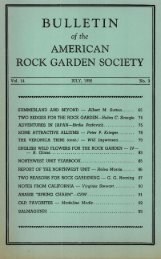Bulletin - Fall 1979 - North American Rock Garden Society
Bulletin - Fall 1979 - North American Rock Garden Society
Bulletin - Fall 1979 - North American Rock Garden Society
You also want an ePaper? Increase the reach of your titles
YUMPU automatically turns print PDFs into web optimized ePapers that Google loves.
landscape.A considerable amount of the Powerof the stony world transplants with surprisingease to the rock garden whenwe develop that connoisseurship of rockswhich rock gardeners sum up in sayingsimply, "That's a good stone", meaningthis is certainly no broken or newlylaid egg of a rock, but shows goodlyage of surface, warm tone, and a livelyshape. As a piece of stonecraft therock garden can't be much better thanits stones, each individually weathered,warm, and lively. The Bower in nature— to return in search of our secondvalue — is that place of environmentalwholeness, surround, and intimacywhich compels us to stay: this is theplace to be. A garden is a gardenonly when it enfolds the gardener insuch a place. Finally, the Flower isthe detail in nature that entertains;each flower is as something to read,and I know rock gardeners to be insatiablereaders of nature. In plantswe read flowers, leaves, roots and all;stone surfaces we read as a goodmystery. The rock garden providesmore to read than any other gardenform, which is to me the reason forits being.High sounding stuff. I wonder now,how is it possible to be a bad stylistin rock gardening when all about usthere is such an exemplary world freefor the looking? And yet even themost faithful observer of wild rock gardenscan go sadly astray when tryingto translate these nature-works into anatural appearing, home-made rock garden.And in naturalistic garden compositiona near miss ranks with falsebrickwork or plastic daffodils. Whathas gone wrong? Some detail canthrow a whole concept into disunity:a scree topping unrelated to the rocksit surrounds, the stones themselves tooregular in outline and set, like buildingblocks, in strata lines too monotonouslyregular, a magnificent rock inappropriatelypedestalled as a lone menhirat the summit of the garden, a curbingof bricks. Anyone of these or severalin combination may destroy the unityof the garden and thus destroy thenatural effect sought by the gardener.Brick curbing, suitable as it maybe in other garden contexts detractsfrom the value of stones — and viceversa.Brick, if it must be used, shouldat least be covered with plants — asingle sort for peaceability: thymewould serve well. Or, the rock gardenmight feature bricks — might usebricks entirely instead of stones, groupingthem from place to place on theside of a hillock as low fragments ofbrick walls, suggesting ruins nearly submergedby accumulated soil, suggestingsimultaneously outcrops of stone. Thelatter would be a far abstraction ofa natural outcrop but the mind wouldmake the merger. Having gone thisfar, would one dare use crushed brickas a scree topping? I believe I would.Why not?'If any of my readers have gone greenand queasy, I'm sorry. But I won't retract.In rock gardening one must, I believe,either recreate free-form naturemeticulously or forget nature almostentirely and frame one's beds withstraight lines and milled or manufacturedmaterials. Imitating nature badlyis the only crime.And yet the classic rock gardendesigned in admiration of wilderness,its mazy paths and well-stocked shelvesadding up to a library of sensualdelight, its cliffs not tall but noble,its stones crusty with aeons of sunand wind, its joints so cunning anInca might pat the gardener on theshoulder, and even a Rustyback Fernwill believe in you — who does notrejoice in this antique, this juicily ro-196









